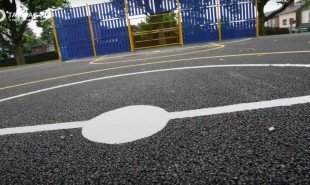
Concrete can be a burden during heavy rainfall. Runoff from the normally impervious material puts pressure on drainage systems, leading to flooding and ice hazards as well as environmental concerns. UK-based Lafarge Tarmac has developed a porous concrete that aims to solve these issues.
Concrete runoff is a major source of localized flooding in urban areas, and pooling water in low temperatures increases the risk of ice patches. Topmix Permeable, however, allows rain water to drain straight through to the underlying water table, easing the burden on existing water drainage systems. This is due to an increased amount of void space in the material — up to 35 percent more than standard concrete, which allows up to 1000ml of water to run through a square meter per minute. The porous concrete also has environmental benefits — the material filters out pollutants that normally runoff into water systems and delivers more water into soil layers, preventing drying out of natural areas. Whilst unsuitable for heavy traffic areas, Topmix Permeable has already provided effective drainage surfaces for pedestrian access areas such as carparks. Other areas of potential utilization include cycle paths, sports pitch borders and paving around new housing development. If large scale adoption occurs, porous concrete may even be a source of city cooling, as evaporation from stored underground water lowers surrounding temperatures.
As urban growth leads to increased surface impermeability, adopting porous concrete can help reduce flooding risks and even help maintain the natural environment around cities. In what other ways could porous materials be used?
Website: www.tarmac.com
Contact: enquiries@tarmac.com
The post Porous concrete helps prevent flooding appeared first on Springwise.




